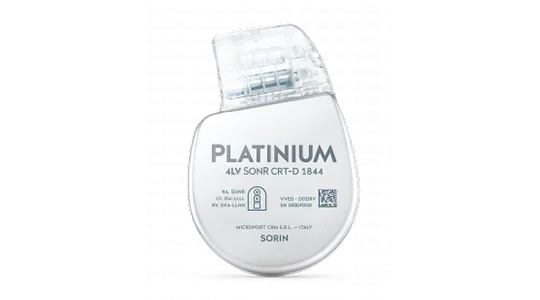Platinium™ 4LV SonR™ CRT-D
Platinium 4LV SonR CRT-D gives every patient a chance to become a responder thanks to multiple therapeutic options and features the world’s longest projected longevity.1
Features
- SonR™: World's only contractility sensor for automatic CRT optimization. 35% risk reduction in heart failure hospitalization.2
- PARAD+™: World’s first dual-chamber discrimination algorithm. Best-in-class 99% specificity.3
- BTO™: Unlock Brady and Tachy therapies in the slow VT zone. 96% specificity. 4
- Multipoint Pacing™: Optimize resynchronization therapy for non-responding heart failure patients.5
This product is not available for sale or distribution in the USA.

Platinium™ 4LV CRT-D
Platinium 4LV CRT-D is small in design with no compromise on longevity: it features the world's longest projected longevity.1
Features
- PARAD+™: World’s first dual-chamber discrimination algorithm. Best-in-class 99% specificity.2
- BTO™: Unlock Brady and Tachy therapies in the slow VT zone. 96% specificity.3
- Multipoint Pacing™: Optimize resynchronization therapy for non-responding heart failure patients.4
Caution: Federal law (USA) restricts this device to sale by or on the order of a physician.

Reply™ CRT-P
Our groundbreaking research has allowed us to develop the world’s smallest Cardiac resynchronization therapy pacemaker 1
Features
- Sleep Apnea MonitoringTM: Early detection, lifetime monitoring. SAM allows you to screen patients for severe sleep apnea as well as monitor the evolution of the disease.
- Dual SensorsTM: Need for accurate Rate Response in CRT. Exercise is proven to have positive effects on mortality, morbidity and quality of life for CRT patients.2,3,4
Caution: Federal law (USA) restricts this device to sale by or on the order of a physician.





